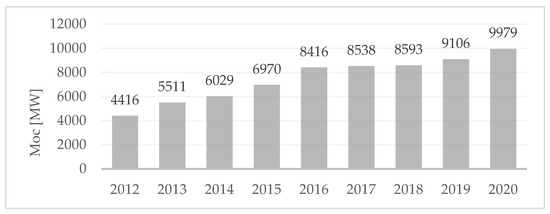Abstract
Due to the European Union, which aspires to pursue an ambitious climate policy, in Poland we have been seeing the development of the energy sector over recent years, reflected by a constantly growing share of green energy. Nevertheless, it is still not enough in relation to the requirements of European law. Europe is to become a climate neutral continent by 2050—if Poland wants to comply with these agreements, it must undergo an energy transformation.
1. Introduction
Along with the improvement of living standards, as well as growth of the population and the development of national economies, the demand for energy has been on the rise. In Poland, power generation is mostly based on coal and lignite combustion; however, experts warn that by maintaining current energy consumption, resources of fossil fuels could be used up as early as 2040. What is more, due to significant environmental pollution and climate change caused by the generation of energy from conventional fuels, many organizations—such as the European Union (EU)—have started to implement measures to protect the environment and promote alternatives such as renewable energy [1]. The analysis of renewable energy source development, as well as Europe’s energy policy, has become a popular topic among scientists in Europe over the last decade.
Alagappan et al. [2] presented a review of renewable energy development in 14 markets that differ in structure, use of feed-in-tariffs, transmission planning and transmission interconnection cost; they found that market restructuring is not a primary factor of renewable energy development. Economidou et al. [3] provided a review of EU energy policies over the last 50 years with a special regard to policy instruments for encouraging measures of energy efficiency in new and existing buildings. Renewable energy development or policy issues were also raised by Kanellakis et al. [4], Abdmouleh et al. [5] and Cullen [6]. This paper aimed to present the development of renewable energy sources (RES) over recent years and describe the EU Policies which influenced it and determined energy policy in Poland.
2. Development and Policy
The development of renewable energy is headed by EU and national policy, increasing ecological awareness in society of new, constantly improving unconventional technologies, as well as of the continuously deteriorating conditions of the environment—especially the air. As shown in Figure 1, in Poland there has been a steady increase in the capacity of installed renewable energy for nearly 10 years. As can be noticed, the total installed capacity of RES in Poland in 2020 was more than twice as high as in 2012. The highest growth (21%) was recorded at the turn of 2015 and 2016.

Figure 1.
Total installed capacity of RES in Poland between 2012–2020. Own study based on [7].
The main reason for such a large increase in the share of RES in energy production was the EU climate and energy package, which imposed an obligation on Poland to achieve a 15% share of RES in gross primary energy consumption. This goal was not achieved, because in 2020 the share of RES in energy production in Poland was approximately 13%. It will be necessary to introduce measures to increase this share as the EU imposes further requirements. The European Green Deal is a strategy by which Europe is to become a climate neutral continent by 2050. It is a response to the climate crisis and to strong processes of environmental degradation [8]. The European Union requires member states to introduce new rules for circular economies, building renovations, biodiversity, agriculture and innovation. Energy transformation will be a significant challenge for Poland.
Author Contributions
A.W. and D.A.K. conceived the subject and carried out the literature review; B.W. analyzed the data; A.W. and B.W. developed the topic and wrote the paper. All authors have read and agreed to the published version of the manuscript.
Acknowledgments
This research was financed by the BUT InterAcademic Partnerships project (PPI/APM/2018/1/00033/U/001) and by the Bialystok University of Technology WZ/WB-IIS/9/2019.
Conflicts of Interest
The authors declare no conflict of interest. The founding sponsors had no role in the design of the study; in the collection, analyses, or interpretation of data; in the writing of the manuscript, and in the decision to publish the results.
References
- Marks-Bielska, R.; Bielski, S.; Pik, K.; Kurowska, K. The Importance of Renewable Energy Sources in Poland’s Energy Mix. Energies 2020, 13, 4624. [Google Scholar] [CrossRef]
- Alagappan, L.; Orans, R.; Woo, C.K. What drives renewable energy development? Energy Policy 2011, 39, 5099–5104. [Google Scholar] [CrossRef]
- Economidou, M.; Todeschi, V.; Bertoldi, P.; D’Agostino, D.; Zangheri, P.; Castellazzi, L. Review of 50 years of EU energy efficiency policies for buildings. Energy Build. 2020, 225, 110322. [Google Scholar] [CrossRef]
- Kanellakis, M.; Martinopoulos, G.; Zachariadis, T. European energy policy—A review. Energy Policy 2013, 62, 1020–1030. [Google Scholar] [CrossRef]
- Abdomuleh, Z.; Alammari, R.A.M.; Gastli, A. Review of policies encouraging renewable energy integration & best practices. Renew. Sustain. Energy Rev. 2015, 45, 249–262. [Google Scholar] [CrossRef]
- Cullen, R. Evaluating renewable energy policies. Aust. J. Agric. Resour. Econ. 2017, 61, 1–18. [Google Scholar] [CrossRef]
- Urząd Regulacji Energetyki. Odnawialne Źródła Energii. Potencjał Krajowy OZE w Liczbach. Available online: https://www.ure.gov.pl/pl/oze/potencjal-krajowy-oze (accessed on 27 March 2021).
- Tomaszewski, K. The Polish road to the new European Green Deal—Challenges and threats to the national energy policy. Energy Policy J. 2020, 23, 5–18. [Google Scholar] [CrossRef]
Publisher’s Note: MDPI stays neutral with regard to jurisdictional claims in published maps and institutional affiliations. |
© 2021 by the authors. Licensee MDPI, Basel, Switzerland. This article is an open access article distributed under the terms and conditions of the Creative Commons Attribution (CC BY) license (https://creativecommons.org/licenses/by/4.0/).